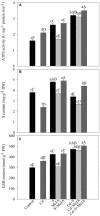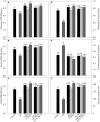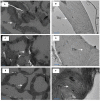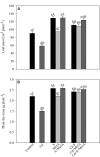Methyl Jasmonate Alleviates Cadmium-Induced Photosynthetic Damages through Increased S-Assimilation and Glutathione Production in Mustard
- PMID: 28066485
- PMCID: PMC5177644
- DOI: 10.3389/fpls.2016.01933
Methyl Jasmonate Alleviates Cadmium-Induced Photosynthetic Damages through Increased S-Assimilation and Glutathione Production in Mustard
Abstract
The effect of methyl jasmonate (MeJA) in mitigation of 50 μM cadmium (Cd) toxicity on structure and function of photosynthetic apparatus in presence or absence of 1.0 mM [Formula: see text] was investigated in mustard (Brassica juncea L. cv. Ro Agro 4001) at 30 days after sowing. Plants exhibited increased oxidative stress, impaired photosynthetic function when grown with Cd, but MeJA in presence of sulfur (S) more prominently ameliorated Cd effects through increased S-assimilation and production of reduced glutathione (GSH) and promoted photosynthetic functions. The transmission electron microscopy showed that MeJA protected chloroplast structure against Cd-toxicity. The use of GSH biosynthetic inhibitor, buthionine sulfoximine (BSO) substantiated the findings that ameliorating effect of MeJA was through GSH production. MeJA could not alleviate Cd effects when BSO was used due to unavailability of GSH even with the input of S. The study shows that MeJA regulates S-assimilation and GSH production for protection of structure and function of photosynthetic apparatus in mustard plants under Cd stress.
Keywords: cadmium toxicity; glutathione; methyl jasmonate; oxidative stress; photosynthesis.
Figures






References
-
- Andresen E., Küpper H. (2013). “Cadmium toxicity in plants,” in Cadmium: From Toxicity to Essentiality eds Sigel A., Sigel H., Sige R. K. O. (Dordrecht: Springer; ) 395–413.
-
- Anjum S. A., Xie X. Y., Farooq M., Wang L. C., Xue L. I., Shahbaz M., et al. (2011). Effect of exogenous methyl jasmonate on growth, gas exchange and chlorophyll contents of soybean subjected to drought. Afr. J. Biotechnol. 24 9647–9656.
LinkOut - more resources
Full Text Sources
Other Literature Sources
Research Materials

